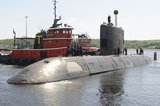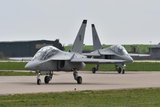Lockheed Martin completes Paveway II Plus Laser Guided Bomb flight test programme
Lockheed Martin has successfully completed the paveway II Plus Laser Guided Bomb (LGB) F/A-18 qualification flight test program. The paveway II Plus LGB uses an enhanced laser guidance package, significantly improving the precision of current paveway II LGBs.
The final mission of the paveway II Plus flight test program consisted of four GBU-10s released from two US Navy Super Hornets at the Navy's China Lake, CA, test ranges. Each weapon included the new paveway II Plus MAU-209C/B computer control group. These four weapons, combined with two released in a prior mission, demonstrated the successful guidance characteristics and improved impact performance of the paveway II Plus weapon system.
"The performance demonstrated during this test program confirmed the precision and pinpoint accuracy of paveway II Plus," said George Kosik, paveway advanced development manager at Lockheed Martin Missiles and Fire Control. "We look forward to demonstrating the same exceptional improvement in capabilities during the upcoming F-16 portion of the flight test program."
Lockheed Martin is a qualified provider of the paveway II LGB, of all three variants of the paveway II MK-80 series LGBs, and is the sole provider of the paveway II Enhanced Laser Guided Training Round and Dual Mode Laser Guided Bomb.
Paveway II LGB guidance kits improve weapon accuracy and reduce risk to US and allied ground forces by converting gravity weapons into precision-guided munitions. Each kit consists of a computer control group, which is the front-end guidance system, plus an air foil group which adds stability fins on the back of each weapon.
Lockheed Martin's LGB kits can be carried on US Air Force, US Navy and most international aircraft platforms currently authorized to carry and release LGBs. Kits are fully compatible and interoperable with existing paveway II LGB logistics infrastructure, equipment, procedures and aircrew operations.
Lockheed Martin has delivered more than 55,000 LGB kits to the US Air Force, US Navy and international customers. Laser-guided bombs have been used successfully in Operation Iraqi Freedom and current overseas contingency operations.
Source: Lockheed Martin
More from Naval Warfare
-
![Maritime defence in the Mediterranean faces challenges from vulnerable land power]()
Maritime defence in the Mediterranean faces challenges from vulnerable land power
As an indispensable energy crossroads, the Mediterranean is at serious risk from grey zone disruption. As navies increasingly employ AI data centres, what happens when cutting-edge defence technologies rely on the very infrastructure most susceptible to hybrid tactics?
-
![US Navy to conduct an experimentation campaign with emerging tech in 2026 and 2027]()
US Navy to conduct an experimentation campaign with emerging tech in 2026 and 2027
The Technology Operational Experimentation Events will inform future requirements as the US Navy looks for innovative solutions across three key operational domains.
-
![Future Canadian Continental Defence Corvette will provide “Halifax-equivalent capabilities”]()
Future Canadian Continental Defence Corvette will provide “Halifax-equivalent capabilities”
Although the CDC project is still in its early stages, the Canadian Department of National Defence already has some requirements for the future platforms.
-
![US Navy to acquire micro-uncrewed underwater vehicles for ISR and coastal data collection]()
US Navy to acquire micro-uncrewed underwater vehicles for ISR and coastal data collection
The Naval Supply Systems Command is seeking authorised resellers of JaiaBot uncrewed underwater vehicles and multivehicle pods. The platforms will support undergraduate education at the US Naval Academy.























